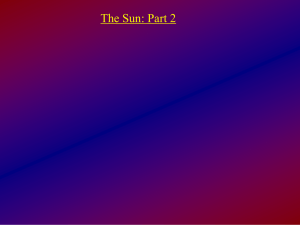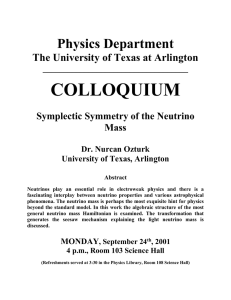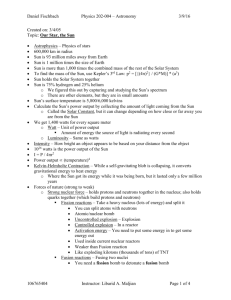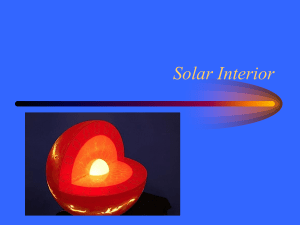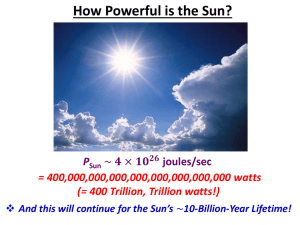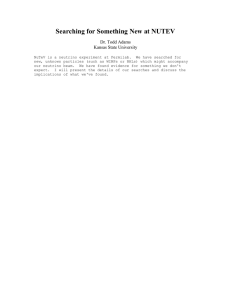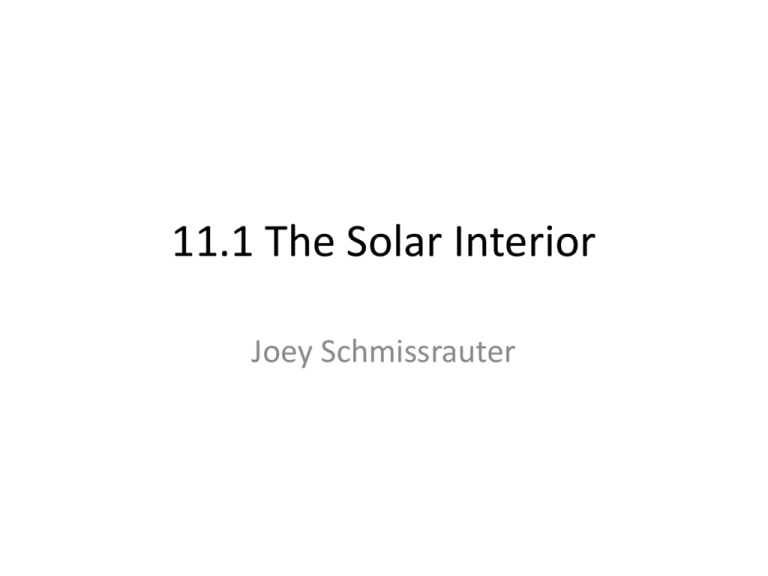
11.1 The Solar Interior
Joey Schmissrauter
Hydrostatic equilibrium
Kelvin-Helmholtz Contraction
It was initially proposed by English
physicist Lord Kelvin and German
scientist Hermann Helmholtz that
compression is what heats the gas
and makes the Sun shine.
Internal Structure of the Sun
• There is rising temperature and density as
we go from the surface of the Sun
towards the center.
• The density at the center of the Sun is
150 g/cm3.
• The temperature at the center of the Sun
is roughly 15 million Kelvin.
• P = nkT, the ideal gas law, applies.
How Solar Energy is transported
• Created in the core by way of
thermonuclear fusion.
• Energy is passed outward by photons which
are emitted and absorbed by atoms (mostly
H and He) in what is called the radiative
zone.
• Just below the photosphere, there is rising
and sinking gas caused by a form of energy
transfer called convection. This is the
convection zone.
Thermal equilibrium
• Energy leaves the Sun in the
form of heat and light. If it
stopped creating energy, it
would collapse in on itself due
to gravity.
• Nuclear fusion was found to be
the most likely and feasible way
that the Sun creates energy.
• Nuclear fusion is possible in the
Sun’s core, because high
temperature allows for the
electrical force between
protons to be overwhelmed by
the strong force.
Proton-Proton chain
The importance of neutrino research
SuperKamiokande
neutrino
detector in
Hida, Japan
•
•
•
Neutrino detectors detect neutrinos that are side products of solar fusion.
By detecting how many neutrinos, we can infer what the temperature and
density are at the core and also get a clear understanding of how the Sun
works.
Neutrino research is very important in backing up solar theory and our
understanding of the Sun’s internal processes.
Works Cited
• Arny, Thomas, and Stephen E. Schneider.
Explorations: an Introduction to Astronomy.
New York, NY: McGraw-Hill, 2008. Print.
• Carroll, Bradley W., and Dale A. Ostlie. An
Introduction to Modern Astrophysics. San
Francisco: Pearson Addison-Wesley, 2007.
Print.
• Fiction Science Reporter. Web. 01 Apr. 2010.
<http://fictionsciencereporter.com/?p=223>.

